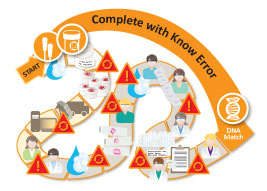The clinical problem of diagnostic errors
Why the know error® system is necessary
 The diagnostic testing cycle for cancer can involve up to 18 steps and several medical professionals working in different locations. Each year, it plays a critical role in determining the diagnoses and corresponding treatments of millions of patients.
The diagnostic testing cycle for cancer can involve up to 18 steps and several medical professionals working in different locations. Each year, it plays a critical role in determining the diagnoses and corresponding treatments of millions of patients.
With such a complex process executed at a large scale, the risk of Specimen Provenance Complications (SPCs) is a serious concern for both physicians and patients. SPCs arise due to instances of biopsy specimen transposition, extraneous/foreign cell contamination and misidentification of cells (patients) that occur in clinical or anatomical pathology. In the case of Biomarker Testing a specimen admixture can cause an incorrect finding and confound the biomarker results. When these SPCs are left undetected, they can lead to serious diagnostic errors and adverse patient outcomes.
When a cancer diagnosis is assigned to the wrong person, the patient with the false-positive diagnosis could receive unnecessary therapy and treatment (chemotherapy, radiation, surgical procedures, etc.) while the patient with the false-negative diagnosis would not receive the care he or she needs in a timely manner.
Learn more about the diagnostic testing cycle. | PDF (2MB)
Learn more about the Biomarkers in the diagnostic testing cycle. | PDF (1.8MB)







